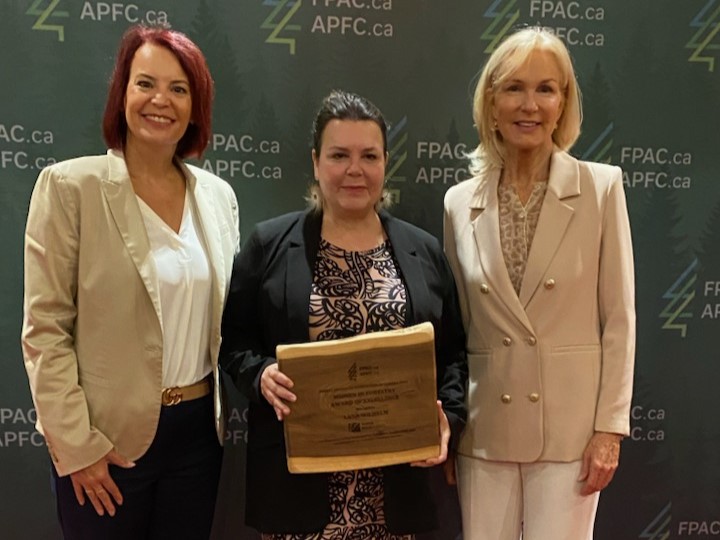We’re proud to announce that Lana Wilhelm, director of Indigenous Relations for Paper Excellence Canada, received the 2024 Women in Forestry Award of Excellence from the Forest Products Association of Canada (FPAC). The prestigious award recognizes the contributions and leadership of women in the forestry sector. Wilhelm and past recipients have demonstrated leadership, innovation and a commitment to the industry.
She says, “The significance of being recognized by your mentors and peers within the forest industry genuinely hits home with me. I’ve been a part of Canada’s forest industry for close to thirty years, and I’m so proud of what the industry continues to achieve. To be recognized by this group is powerful and impactful.”
A Spirit of Stewardship
To understand the significance of this FPAC award and the role of women in forestry, you have to go back to the beginning of Wilhelm’s involvement in the industry. She has worked Paper Excellence for nearly five years and has decades of experience working in forestry and with First Nations resources. Wilhelm found an interest in forestry in her early twenties, when she started planting trees in remote cutblocks in western Canada. But that interest turned into a passion when she began working in soils and ecology research on Haida Gwaii, an archipelago off the northern Pacific coast of Canada.
Then Wilhelm spent time designing cutblocks and protecting cultural value areas as part of a First Nation 1,000-year cedar strategy. Wilhelm also has experience managing Indigenous contractor work in road building and rehabilitation.
“Learning from coastal First Nations cultural values on the ground fired me up with this vision of how I wanted to be a part of a forest industry that worked together,” she says of her Indigenous relations work. “That stewardship spirit is what brought me to working with Indigenous communities. I love the weaving together of Indigenous culture and western science. It’s a place where we all win. Really, the weaving together is where I started my career, and it still informs my work today.”
Forestry With a Purpose
Today, as director of Indigenous Relations, Wilhelm builds on her past experiences working with First Nations and helping to develop programs to protect their forestry interests.
“Companies can leverage the deep knowledge and unique skillsets Indigenous people bring to the table in sophisticated partnerships,” she explains. “Recognizing that value and having it lead to long-term sustainable employment and procurement policies that drive change is key to any Indigenous Relations program, and that’s valuable to me and to our sector as a whole.”
Wilhelm points to two projects, in particular, that stand out as especially impactful and meaningful. “Early in my career, back when consultation wasn’t even yet enshrined in law, I worked with Indigenous Knowledge Keepers to incorporate their values in forest planning. I faced enormous pushback from the licensees of the day, and it definitely impacted my career options at that time. But standing with conviction beside elders will always make me proud,” she explains. “More recently, being a leader in building an entire ‘soup to nuts’ Indigenous Relations program at Paper Excellence Canada has been extremely rewarding. It’s a significant piece of teamwork, and not everyone gets that kind of opportunity in their career.”
Wilhelm is currently chairing the new Integrated Indigenous Relations Steering Committee, which she says has made her really appreciate the resilience and care demonstrated by her colleagues across of the Canadian forest industry. Together, they’re finding common themes across Canada’s various regions and cultural differences.
“The Canadian forest industry is not perfect,” she says. “But we’re facing those challenging conversations — about species at risk like caribou, Indigenous Reconciliation, old growth management. We’re facing so many challenges head on, even though the conversations can be slow and complicated. That takes a lot of courage.”
Indigenous Relations Drives Reconciliation
When asked what it’s like to see Indigenous Relations and reconciliation in action within the industry, she points to one instance where hourly mill employees participated in blanket exercises with Indigenous cultural experts. “That was pretty powerful,” she says. “Having them so willingly take part in very vulnerable places in cultural training shows the hunger within average Canadians in the forest industry to learn about and understand what truth and reconciliation means and take responsibility for learning the history of colonization.”
She hopes that kind of hunger will translate into decades of positive change ahead, fueled by challenging the policy of what good forestry is through both a social and an environmental lens. “Within the industry there’s a real capacity and a willingness to keep learning and growing,” she says.
